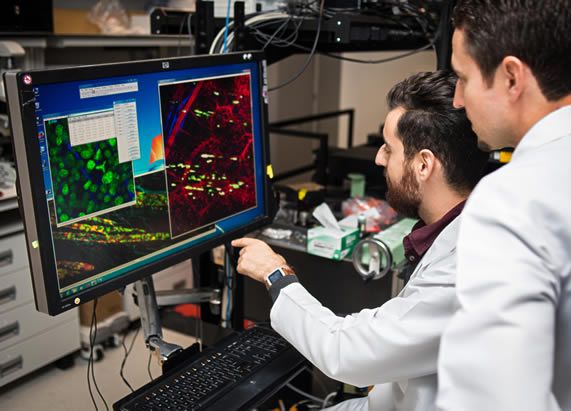PhD Public Seminar: MICHAEL LONGMIRE
When & Where
April 23
2:30 PM - 3:30 PM
UTHealth Houston,. MD Anderson Cancer Center, BSRB S3.8371 (GSB S Large Classroom) and via Zoom (View in Google Map)
Contact
- Joy Lademora
- 7135009872
- [email protected]
Event Description
Expanding Inducible Epithelial Resistance Against Pneumonia: Novel Virus, Nover Receptor
Michael Longmire, BS (Advisor: Scott Evans, MD)
Pneumonia is the leading infectious cause of death worldwide and presents a continuing risk among immunocompromised patients. Our work has been focused for many years on the phenomenon of inducible epithelial resistance, where activation of the innate immune response in the airway epithelium is necessary and sufficient to produce a pathogen-killing but self-protective environment to prevent severe disease. Inducible resistance is pathogen-agnostic and has been demonstrated against an array of respiratory infections. We achieve this using a combination of pattern recognition receptor agonists – Pam2CSK4 and ODN M362 being the current formulation – which produce synergistic levels of pathogen reduction and protection in our models. Recent endeavors by members of our lab have sought to identify and characterize the mechanisms which contribute to synergy including the release of reactive oxygen species, production of antimicrobial peptides and proinflammatory cytokines, and the identification of alternative receptors and pathways for our ligands. In this work, I have developed a new model for multi-system coronavirus disease using the murine coronavirus MHV-A59 which infects the respiratory epithelium before disseminating to multiple organ systems. Pam2/ODN treatment decreased morbidity and mortality associated with MHV infection, limited lung injury and spread to other organs, and produced a unique gene expression signature in epithelial cells to diminish the impact of infection. I have also pursued describing the activation cascade of RIG-I as a newly identified receptor for ODN. I have demonstrated that the RIG-I:ODN interaction is not determined by ODN sequence, secondary structure, or CpG motifs, but is instead dependent on the phosphorothioate-modified backbone common in immunostimulatory ODNs. I have also shown that ODN leads to the activation of IRF3, a transcription factor and downstream component of RIG-I signaling, as well as the upregulation of IRF3-regulated genes. Together, the findings of this thesis expand our understanding of inducible epithelial resistance both at the level of molecular mechanisms of protection and at the translational level of characterizing new applications against novel pathogens.
Advisory Committee:
- Scott Evans, MD, Chair
- Jun-ichi Abe, MD, PhD
- George Calin, MD, PhD
- Shane Cunha, PhD
- Harry Karmouty-Quintana, PhD
- Samuel Shelburne, MD, PhD
Join via Zoom (Please contact Mr. Michael Longmire for his Zoom meeting info)
Expanding Inducible Epithelial Resistance Against Pneumonia: Novel Virus, Nover Receptor
Michael Longmire, BS (Advisor: Scott Evans, MD)
Pneumonia is the leading infectious cause of death worldwide and presents a continuing risk among immunocompromised patients. Our work has been focused for many years on the phenomenon of inducible epithelial resistance, where activation of the innate immune response in the airway epithelium is necessary and sufficient to produce a pathogen-killing but self-protective environment to prevent severe disease. Inducible resistance is pathogen-agnostic and has been demonstrated against an array of respiratory infections. We achieve this using a combination of pattern recognition receptor agonists – Pam2CSK4 and ODN M362 being the current formulation – which produce synergistic levels of pathogen reduction and protection in our models. Recent endeavors by members of our lab have sought to identify and characterize the mechanisms which contribute to synergy including the release of reactive oxygen species, production of antimicrobial peptides and proinflammatory cytokines, and the identification of alternative receptors and pathways for our ligands. In this work, I have developed a new model for multi-system coronavirus disease using the murine coronavirus MHV-A59 which infects the respiratory epithelium before disseminating to multiple organ systems. Pam2/ODN treatment decreased morbidity and mortality associated with MHV infection, limited lung injury and spread to other organs, and produced a unique gene expression signature in epithelial cells to diminish the impact of infection. I have also pursued describing the activation cascade of RIG-I as a newly identified receptor for ODN. I have demonstrated that the RIG-I:ODN interaction is not determined by ODN sequence, secondary structure, or CpG motifs, but is instead dependent on the phosphorothioate-modified backbone common in immunostimulatory ODNs. I have also shown that ODN leads to the activation of IRF3, a transcription factor and downstream component of RIG-I signaling, as well as the upregulation of IRF3-regulated genes. Together, the findings of this thesis expand our understanding of inducible epithelial resistance both at the level of molecular mechanisms of protection and at the translational level of characterizing new applications against novel pathogens.
Advisory Committee:
- Scott Evans, MD, Chair
- Jun-ichi Abe, MD, PhD
- George Calin, MD, PhD
- Shane Cunha, PhD
- Harry Karmouty-Quintana, PhD
- Samuel Shelburne, MD, PhD
Join via Zoom (Please contact Mr. Michael Longmire for his Zoom meeting info)
", "startDate":"2025-4-23", "endDate":"2025-4-23", "startTime":"14:30", "endTime":"15:30", "location":"UTHealth Houston,. MD Anderson Cancer Center, BSRB S3.8371 (GSB S Large Classroom) and via Zoom", "label":"Add to Calendar", "options":[ "Apple", "Google", "iCal", "Microsoft365", "MicrosoftTeams", "Yahoo" ], "timeZone":"America/Chicago", "trigger":"click", "inline":true, "listStyle":"modal", "iCalFileName":"Reminder-Event" }






